1 of 27
Download to read offline

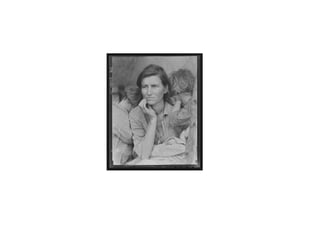
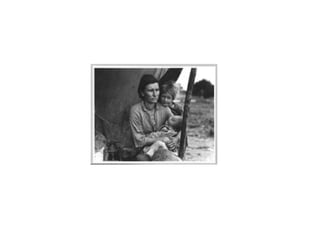

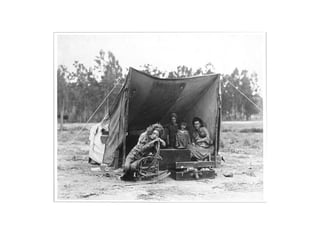
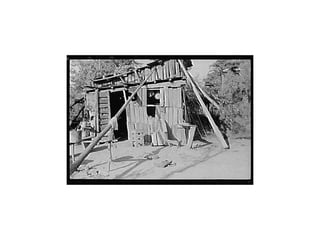

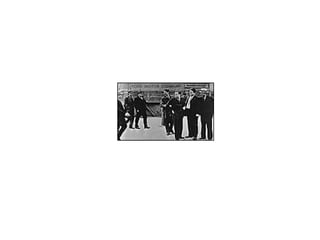

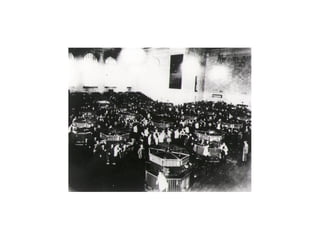




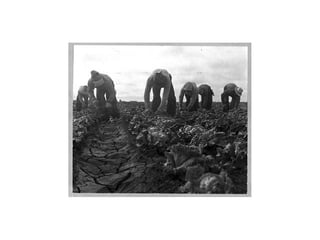
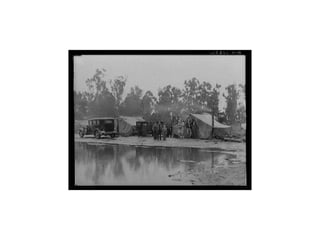

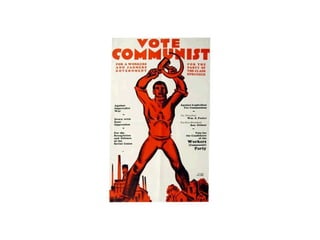


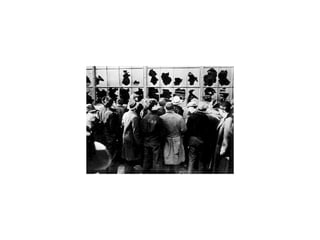
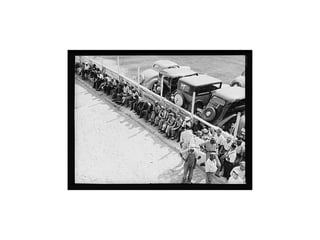





Ad
Recommended
Nazi germany
Nazi germanymr1861
╠²
The document provides an overview of the rise of Nazi Germany beginning with Adolf Hitler's early life and political activities following World War 1. It describes key events that allowed the Nazis to rise to power such as the 1923 Beer Hall Putsch, Hitler's time in prison writing Mein Kampf, and the Great Depression which increased support for the Nazi party. The Nazis capitalized on fears of communism and economic instability to gain a majority in the Reichstag in 1933, allowing Hitler to consolidate power and transform Germany into a totalitarian Nazi state by 1935 with the Nuremberg Laws.His 3002 Ch 19 Lecture
His 3002 Ch 19 Lecturemr1861
╠²
The document summarizes the subjugation of Native Americans in the West through warfare, confinement to reservations, and attempts to destroy their culture. It describes the construction of transcontinental railroads which integrated the West into the national economy and attracted large numbers of migrants seeking work. It discusses how mining, ranching, and farming shifted from individual pursuits to corporate enterprises in the West.Russian Revolution
Russian Revolutionmr1861
╠²
The document summarizes the Russian Revolution from 1917 to 1920. It describes how Czar Nicholas II's poor leadership and Russia's losses in World War I led to growing unrest in the country. In February 1917, widespread strikes and protests erupted, ultimately forcing Nicholas II to abdicate in March 1917. A provisional government took over but struggled to stabilize Russia as the Bolsheviks, led by Lenin, Trotsky, and Stalin, gained popularity by promising to take Russia out of World War I and redistribute land to peasants. In October 1917, the Bolsheviks seized power in the October Revolution.What historians do
What historians domr1861
╠²
This document discusses what historians do and the craft of history. It addresses questions around what should be studied in history, the aims and purposes of studying history, and validity and approaches in history. Specifically, it explores studying history to illuminate the past, broaden possibilities for the future, and understand who we are. It also notes history can be studied for practical purposes like teaching, law, government work and more.Facism
Facismmr1861
╠²
Fascism is a totalitarian philosophy that glorifies the state and assigns it control over all aspects of national life. Fascism emerged in post-WWI Italy in response to nationalism, socialism, and fears of social disorder. Benito Mussolini founded the fascist movement and rose to power as Prime Minister in 1922, establishing a dictatorship and cult of personality around himself. Mussolini imposed a totalitarian regime through propaganda, indoctrination of youth, and suppression of dissent. However, fascism in Italy lacked the effectiveness of other totalitarian states and compromised with existing power structures like the Catholic Church.Taylor f. railroads
Taylor f. railroadstfisk
╠²
Railroads were first developed in Great Britain and introduced to the United States during the Industrial Revolution. They provided a fast way to transport people and goods across long distances, helping drive economic growth but also negatively impacted Native Americans by destroying buffalo populations, seizing land, and exposing workers to harsh racial views.His 3002 Visuals Ch18
His 3002 Visuals Ch18mr1861
╠²
The document discusses trends in immigration, urbanization, and industry in the United States between 1870-1900. Millions of immigrants arrived from southern and eastern Europe during this time period, contributing to the rapid growth and industrial transformation of American cities. As the country became more urbanized and industrialized, workers increasingly left farms to work in factories under sometimes difficult conditions.Nazi germany
Nazi germanymr1861
╠²
This document provides an overview of Adolf Hitler's rise to power in Germany from the 1920s to 1933. It discusses his early life and political activities, including his failed 1923 Beer Hall Putsch and time in prison writing Mein Kampf. It then covers the Nazis rebuilding their party and gaining electoral success as the German economy declined. Finally, it summarizes how Hitler was appointed Chancellor in 1933 and quickly consolidated power, establishing a Nazi police state and one-party rule over Germany.Facism
Facismmr1861
╠²
Fascism is defined as a totalitarian philosophy that glorifies the state and assigns it control over all aspects of national life. Fascists believe the state is absolute and individuals exist to serve it. Fascism in Italy began after World War 1, led by Benito Mussolini. Mussolini used his Fascist squads, known as Squadristi, to gain power through violence and intimidation. By 1922, Mussolini had become Prime Minister through threats of chaos. He established a totalitarian fascist state ruled by his Fascist Party, though it was ineffective and compromised with the Catholic Church.Cultural theory and the age of imperialism
Cultural theory and the age of imperialismmr1861
╠²
The document discusses several intellectual and social theories in the 19th century that helped enable and justify European imperialism, including social Darwinism, nationalism, and anti-Semitism. Key figures discussed include Karl Marx, Charles Darwin, and their influences on political and economic thought during this period. The rise of new imperialism in the late 19th century is examined, driven by economic, military, and ideological factors. Responses to imperialism, such as resistance movements, are also mentioned.Pre columbian-2 spanish period
Pre columbian-2 spanish periodmr1861
╠²
The document provides a brief overview of Florida's history from its emergence from the sea millions of years ago to the end of the First Spanish Period when Florida became a British territory. It mentions that native Floridians had a closer connection to nature than other North American tribes. It then discusses some of the early Spanish explorers like Juan Ponce de Leon and Pedro Menendez de Aviles who founded St. Augustine in 1565. The document also notes some of the tensions between the Spanish, French, English and native Americans during this time period over land and slavery that eventually led to Florida changing hands after the French and Indian War.French and Indian War to Statehoood
French and Indian War to Statehooodmr1861
╠²
- During the Second Spanish Period, Spain's hold on Florida was tenuous and it never stood a chance against America's expansionist appetite.
- From 1764-1783, Florida experienced two decades of British rule where it was split into two colonies - East and West Florida. The British colonies enjoyed economic growth and development that exceeded the Spanish during the previous 200 years.
- After the American Revolution, East Florida remained loyal to Britain and saw its population grow while West Florida was taken by Spain in 1781. Florida then reverted to Spanish control, though Spain took an economic approach to try and maintain its colonies.Sample HU 300
Sample HU 300mr1861
╠²
This document is a letter written by a 42-year-old mother of two from East Orange, New Jersey. She provides details about her family background, daily activities, goals and aspirations which include owning her own restaurant and obtaining a criminal justice degree. She discusses her views on morality, happiness, and includes summaries of several significant literary works, including a short story, song and film, that have positive messages about overcoming challenges and looking forward to a better future.Cultural theory and the age of imperialism
Cultural theory and the age of imperialismmr1861
╠²
This document discusses several intellectual and social currents in the 19th century that influenced the age of imperialism, including:
1) Karl Marx's social theories and critiques of capitalism which reflected the social upheaval of the time.
2) Charles Darwin's theory of evolution by natural selection which radically changed conceptions of time and biology and led to social Darwinism and scientific racism.
3) The rise of racial nationalism, anti-Semitism, and social Darwinism in Europe which supported imperialism and notions of European/Anglo-Saxon superiority.
4) New imperialism in the late 19th century driven by economic and nationalistic motives to acquire foreign territories and resources.The Presidency
The Presidencymr1861
╠²
The document discusses the history and powers of the US presidency. It covers the roots of the office in the Constitution, the qualifications and terms for president, and the powers granted like commander-in-chief. It also examines how the power of the presidency has grown over time, with the expansion of the White House staff and use of media. Modern presidents play an active role in both domestic and foreign policymaking while also acting as a symbol for the nation.Hist 4020 Federalism
Hist 4020 Federalismmr1861
╠²
The document discusses the concept of federalism in the United States, including the division of powers between the national and state governments. It explains that the national government has exclusive and concurrent powers, while states have reserved powers. The document also covers how new states are admitted to the union, the obligations the constitution places on the national government to support states, and mechanisms for cooperation between states like interstate compacts.HIST 4020 Constitution
HIST 4020 Constitutionmr1861
╠²
The document outlines the six basic principles of the US Constitution: popular sovereignty, limited government, separation of powers, checks and balances, judicial review, and federalism. It also discusses the process of formal amendment, noting that the Constitution has been amended 27 times to address needed changes over time. Additionally, it analyzes how the Constitution has evolved through means other than formal amendment, such as legislation, executive actions, judicial decisions, and political customs and norms.HIST 4020 Intro
HIST 4020 Intromr1861
╠²
This document discusses the roots and evolution of American political culture and government. It covers the philosophical influences on America's founding, such as ideas from Aristotle, the Greeks, Hobbes, Locke, and Rousseau. It also examines the key characteristics of American democracy, including popular consent, majority rule, and individualism. Additionally, it outlines changes in the US population over time including increasing diversity and an aging population. The document concludes by looking at modern American political ideologies like conservatism, liberalism, and libertarianism as well as views of and expectations toward the government.Myth
Mythmr1861
╠²
This document discusses how popular mythology and common sayings are expressions of myths that form the basis of thought patterns. It also discusses how myths from childhood offer reassurance and recognize gender roles and good versus evil. Myths help people understand natural phenomena and human tragedy. The document notes that archetypes in mythology, like the monomyth and concepts of power, journey, and garden, are keys to understanding common threads that link all cultures throughout time.sample portfolio
sample portfoliomr1861
╠²
This course helped improve the student's analytical skills through assignments like consensus reports and reflection papers. The consensus reports required discussing ethical issues as a class and coming to an agreement, which the student initially struggled with but improved at being more specific. The reflection papers allowed the student to practice scientific writing styles. Through examining topics like cloning, affirmative action, and animal rights from multiple perspectives, the student was challenged to better define their own beliefs while considering opposing views. Overall, the course helped the student think more critically about applying ethics to modern issues and their own lives.Hist 3001 Ch 03 Lecture
Hist 3001 Ch 03 Lecturemr1861
╠²
The document discusses the interactions between Native Americans, Europeans, and Africans in early America. It describes how the Spanish, French, and English utilized Native American labor through systems like encomienda and repartimiento. It also discusses how the fur trade led the French to exercise more control over Native Americans and eventually caused violence. Additionally, it outlines how Europeans turned to African slavery to solve labor needs, and how slavery became firmly established in the Southern colonies.Hist 3001 Ch 02 Lecture
Hist 3001 Ch 02 Lecturemr1861
╠²
1) The document discusses the development of European colonies in North America and the Caribbean during the 17th century, including the founding and growth of the French, Dutch, and English colonies.
2) It addresses topics like the fur trade that drove French colonization, the establishment of plantations and slave societies in the Caribbean and southern colonies, and the founding of New England for religious reasons.
3) The various colonies developed different economic bases, including tobacco in Virginia, sugar in the Caribbean, and a diversity of crops in New England, with most establishing relations with local indigenous groups.Hist 3001 Ch 01 Lecture
Hist 3001 Ch 01 Lecturemr1861
╠²
The document discusses Native American, West African, and European societies prior to contact between the Old World and New World in 1492. It describes the political, social, and economic structures of these societies, including advanced civilizations in Mesoamerica and West Africa. Upon contact, European diseases devastated Native American populations while European powers conquered empires like the Aztecs and Incas. The Columbian Exchange introduced new crops, livestock, and diseases globally in one of the most consequential events in human history. European nations then competed to establish colonies in North America.Literture
Literturemr1861
╠²
The document discusses different literary genres and their purposes throughout history. It explains that literature serves to define times and share ideas through elevated styles like poetry and complex fictional forms like novels. Some famous poets mentioned are Sappho, Shakespeare, Lorca, and Dickinson. Novels are described as developing to tell fictional stories not found in history. Short stories emerged as a format that could be enjoyed in a single sitting.Literature
Literaturemr1861
╠²
This document discusses different forms of literature and some notable authors in each form. It covers literature as a way to understand history, poetry as a means of sharing ideas in an elevated style, and novels and short stories as fictional forms of complex stories. Some famous poets mentioned are Sappho, Petrarch, Shakespeare, Lorca, Donne, Basho, Issa, Blake, and Dickinson. Novels like Don Quixote and The Great Gatsby are discussed, as well as short stories by Poe and Jackson.Happiness
Happinessmr1861
╠²
The document discusses different philosophical views on happiness:
1) Hedonism sees happiness as obtaining as much pleasure as possible. Epicureanism sees it as freedom from pain through moderation of pleasure. Stoicism finds happiness by controlling desires and accepting inevitability of pain.
2) Aristotle believed true happiness is a lasting state where nothing more is desired, not just momentary pleasure. He also thought governments should promote conditions for citizens to achieve happiness.
3) Modern expansions of Aristotle's view link societal institutions and government policies to long-term well-being and happiness of populations.Freedom
Freedommr1861
╠²
The document discusses different views on determinism and freedom. It describes several types of determinism that suggest factors like predestination, social institutions, economic class, conditioning, genetics and genes limit human freedom. It also discusses libertarian views that propose the possibility of free will. These include the ideas that free will allows both positive and negative outcomes, and that indeterminism means the world is random due to people's unpredictable actions. The document also discusses psychoanalysis as a way to free the mind and existentialist views that while we have freedom to choose our faiths and actions, we must accept responsibility for the consequences.Happiness
Happinessmr1861
╠²
The document discusses different philosophical views on happiness:
1) Hedonism sees happiness as obtaining as much pleasure as possible. Epicureanism sees it as freedom from pain through moderation of pleasure. Stoicism finds happiness by controlling desires and accepting inevitability of pain.
2) Aristotle believed true happiness is a lasting state where nothing more is desired, not just momentary pleasure. He also believed society and government exist to promote happiness for all.
3) Modern expansions of Aristotle's view think more about how social structures can achieve widespread and lasting happiness.More Related Content
More from mr1861 (20)
Facism
Facismmr1861
╠²
Fascism is defined as a totalitarian philosophy that glorifies the state and assigns it control over all aspects of national life. Fascists believe the state is absolute and individuals exist to serve it. Fascism in Italy began after World War 1, led by Benito Mussolini. Mussolini used his Fascist squads, known as Squadristi, to gain power through violence and intimidation. By 1922, Mussolini had become Prime Minister through threats of chaos. He established a totalitarian fascist state ruled by his Fascist Party, though it was ineffective and compromised with the Catholic Church.Cultural theory and the age of imperialism
Cultural theory and the age of imperialismmr1861
╠²
The document discusses several intellectual and social theories in the 19th century that helped enable and justify European imperialism, including social Darwinism, nationalism, and anti-Semitism. Key figures discussed include Karl Marx, Charles Darwin, and their influences on political and economic thought during this period. The rise of new imperialism in the late 19th century is examined, driven by economic, military, and ideological factors. Responses to imperialism, such as resistance movements, are also mentioned.Pre columbian-2 spanish period
Pre columbian-2 spanish periodmr1861
╠²
The document provides a brief overview of Florida's history from its emergence from the sea millions of years ago to the end of the First Spanish Period when Florida became a British territory. It mentions that native Floridians had a closer connection to nature than other North American tribes. It then discusses some of the early Spanish explorers like Juan Ponce de Leon and Pedro Menendez de Aviles who founded St. Augustine in 1565. The document also notes some of the tensions between the Spanish, French, English and native Americans during this time period over land and slavery that eventually led to Florida changing hands after the French and Indian War.French and Indian War to Statehoood
French and Indian War to Statehooodmr1861
╠²
- During the Second Spanish Period, Spain's hold on Florida was tenuous and it never stood a chance against America's expansionist appetite.
- From 1764-1783, Florida experienced two decades of British rule where it was split into two colonies - East and West Florida. The British colonies enjoyed economic growth and development that exceeded the Spanish during the previous 200 years.
- After the American Revolution, East Florida remained loyal to Britain and saw its population grow while West Florida was taken by Spain in 1781. Florida then reverted to Spanish control, though Spain took an economic approach to try and maintain its colonies.Sample HU 300
Sample HU 300mr1861
╠²
This document is a letter written by a 42-year-old mother of two from East Orange, New Jersey. She provides details about her family background, daily activities, goals and aspirations which include owning her own restaurant and obtaining a criminal justice degree. She discusses her views on morality, happiness, and includes summaries of several significant literary works, including a short story, song and film, that have positive messages about overcoming challenges and looking forward to a better future.Cultural theory and the age of imperialism
Cultural theory and the age of imperialismmr1861
╠²
This document discusses several intellectual and social currents in the 19th century that influenced the age of imperialism, including:
1) Karl Marx's social theories and critiques of capitalism which reflected the social upheaval of the time.
2) Charles Darwin's theory of evolution by natural selection which radically changed conceptions of time and biology and led to social Darwinism and scientific racism.
3) The rise of racial nationalism, anti-Semitism, and social Darwinism in Europe which supported imperialism and notions of European/Anglo-Saxon superiority.
4) New imperialism in the late 19th century driven by economic and nationalistic motives to acquire foreign territories and resources.The Presidency
The Presidencymr1861
╠²
The document discusses the history and powers of the US presidency. It covers the roots of the office in the Constitution, the qualifications and terms for president, and the powers granted like commander-in-chief. It also examines how the power of the presidency has grown over time, with the expansion of the White House staff and use of media. Modern presidents play an active role in both domestic and foreign policymaking while also acting as a symbol for the nation.Hist 4020 Federalism
Hist 4020 Federalismmr1861
╠²
The document discusses the concept of federalism in the United States, including the division of powers between the national and state governments. It explains that the national government has exclusive and concurrent powers, while states have reserved powers. The document also covers how new states are admitted to the union, the obligations the constitution places on the national government to support states, and mechanisms for cooperation between states like interstate compacts.HIST 4020 Constitution
HIST 4020 Constitutionmr1861
╠²
The document outlines the six basic principles of the US Constitution: popular sovereignty, limited government, separation of powers, checks and balances, judicial review, and federalism. It also discusses the process of formal amendment, noting that the Constitution has been amended 27 times to address needed changes over time. Additionally, it analyzes how the Constitution has evolved through means other than formal amendment, such as legislation, executive actions, judicial decisions, and political customs and norms.HIST 4020 Intro
HIST 4020 Intromr1861
╠²
This document discusses the roots and evolution of American political culture and government. It covers the philosophical influences on America's founding, such as ideas from Aristotle, the Greeks, Hobbes, Locke, and Rousseau. It also examines the key characteristics of American democracy, including popular consent, majority rule, and individualism. Additionally, it outlines changes in the US population over time including increasing diversity and an aging population. The document concludes by looking at modern American political ideologies like conservatism, liberalism, and libertarianism as well as views of and expectations toward the government.Myth
Mythmr1861
╠²
This document discusses how popular mythology and common sayings are expressions of myths that form the basis of thought patterns. It also discusses how myths from childhood offer reassurance and recognize gender roles and good versus evil. Myths help people understand natural phenomena and human tragedy. The document notes that archetypes in mythology, like the monomyth and concepts of power, journey, and garden, are keys to understanding common threads that link all cultures throughout time.sample portfolio
sample portfoliomr1861
╠²
This course helped improve the student's analytical skills through assignments like consensus reports and reflection papers. The consensus reports required discussing ethical issues as a class and coming to an agreement, which the student initially struggled with but improved at being more specific. The reflection papers allowed the student to practice scientific writing styles. Through examining topics like cloning, affirmative action, and animal rights from multiple perspectives, the student was challenged to better define their own beliefs while considering opposing views. Overall, the course helped the student think more critically about applying ethics to modern issues and their own lives.Hist 3001 Ch 03 Lecture
Hist 3001 Ch 03 Lecturemr1861
╠²
The document discusses the interactions between Native Americans, Europeans, and Africans in early America. It describes how the Spanish, French, and English utilized Native American labor through systems like encomienda and repartimiento. It also discusses how the fur trade led the French to exercise more control over Native Americans and eventually caused violence. Additionally, it outlines how Europeans turned to African slavery to solve labor needs, and how slavery became firmly established in the Southern colonies.Hist 3001 Ch 02 Lecture
Hist 3001 Ch 02 Lecturemr1861
╠²
1) The document discusses the development of European colonies in North America and the Caribbean during the 17th century, including the founding and growth of the French, Dutch, and English colonies.
2) It addresses topics like the fur trade that drove French colonization, the establishment of plantations and slave societies in the Caribbean and southern colonies, and the founding of New England for religious reasons.
3) The various colonies developed different economic bases, including tobacco in Virginia, sugar in the Caribbean, and a diversity of crops in New England, with most establishing relations with local indigenous groups.Hist 3001 Ch 01 Lecture
Hist 3001 Ch 01 Lecturemr1861
╠²
The document discusses Native American, West African, and European societies prior to contact between the Old World and New World in 1492. It describes the political, social, and economic structures of these societies, including advanced civilizations in Mesoamerica and West Africa. Upon contact, European diseases devastated Native American populations while European powers conquered empires like the Aztecs and Incas. The Columbian Exchange introduced new crops, livestock, and diseases globally in one of the most consequential events in human history. European nations then competed to establish colonies in North America.Literture
Literturemr1861
╠²
The document discusses different literary genres and their purposes throughout history. It explains that literature serves to define times and share ideas through elevated styles like poetry and complex fictional forms like novels. Some famous poets mentioned are Sappho, Shakespeare, Lorca, and Dickinson. Novels are described as developing to tell fictional stories not found in history. Short stories emerged as a format that could be enjoyed in a single sitting.Literature
Literaturemr1861
╠²
This document discusses different forms of literature and some notable authors in each form. It covers literature as a way to understand history, poetry as a means of sharing ideas in an elevated style, and novels and short stories as fictional forms of complex stories. Some famous poets mentioned are Sappho, Petrarch, Shakespeare, Lorca, Donne, Basho, Issa, Blake, and Dickinson. Novels like Don Quixote and The Great Gatsby are discussed, as well as short stories by Poe and Jackson.Happiness
Happinessmr1861
╠²
The document discusses different philosophical views on happiness:
1) Hedonism sees happiness as obtaining as much pleasure as possible. Epicureanism sees it as freedom from pain through moderation of pleasure. Stoicism finds happiness by controlling desires and accepting inevitability of pain.
2) Aristotle believed true happiness is a lasting state where nothing more is desired, not just momentary pleasure. He also thought governments should promote conditions for citizens to achieve happiness.
3) Modern expansions of Aristotle's view link societal institutions and government policies to long-term well-being and happiness of populations.Freedom
Freedommr1861
╠²
The document discusses different views on determinism and freedom. It describes several types of determinism that suggest factors like predestination, social institutions, economic class, conditioning, genetics and genes limit human freedom. It also discusses libertarian views that propose the possibility of free will. These include the ideas that free will allows both positive and negative outcomes, and that indeterminism means the world is random due to people's unpredictable actions. The document also discusses psychoanalysis as a way to free the mind and existentialist views that while we have freedom to choose our faiths and actions, we must accept responsibility for the consequences.Happiness
Happinessmr1861
╠²
The document discusses different philosophical views on happiness:
1) Hedonism sees happiness as obtaining as much pleasure as possible. Epicureanism sees it as freedom from pain through moderation of pleasure. Stoicism finds happiness by controlling desires and accepting inevitability of pain.
2) Aristotle believed true happiness is a lasting state where nothing more is desired, not just momentary pleasure. He also believed society and government exist to promote happiness for all.
3) Modern expansions of Aristotle's view think more about how social structures can achieve widespread and lasting happiness.